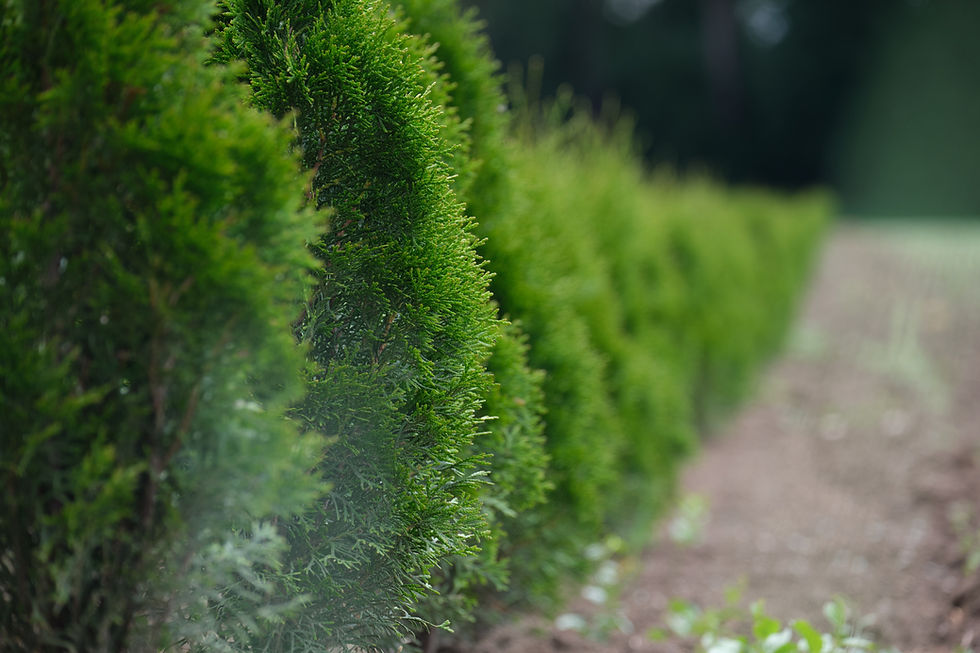
A tractor hedge cutter for cutting a hedgerow having a root mass, stalks, branches and foliage, into smaller hedgerow segments is made of a frame, having a vertically oriented centerline, adapted for attachment to a powered vehicle sized and configured to travel alongside, and parallel to a hedgerow, a root cutting spade assembly sized to be driven down and thru the thought mass of the hedgerow to chop and thereby separate a segment of the hedgerow root mass from the hedgerow and an elongated tractor hedge cutter assembly, for cutting through the hedgerow stalks, branches and foliage, said tractor hedge trimmer assembly attached to the upper portion of the spade assembly and oriented to increase generally upwardly and means for extending the thought cutting spade assembly outwardly and downwardly faraway from the centerline and into the hedgerow root mass to separate the thought mass of the hedgerow segment from the hedgerow and increasing the tractor hedge cutter assembly into the stems, branches and foliage of the hedgerow to distribute the hedgerow section from the hedgerow.
This invention generally relates to the separation of pre-grown hedges into transportable units and more particularly to a hydraulic hedge separator which may be wont to simultaneously separate the foliage and thus the idea ball of a preselected length of hedge from a way bigger row of hedge.
There is ongoing growth within the landscaping industry at large. the utilization of pre-grown sod as a substitute of seed planting for lawn grasses has become much more common and widely accepted. an equivalent are often said for nursery grown trees, bushes, flowering shrubs and thus the likes of it is not uncommon for a newly constructed home or other building to then be landscaped to the extent that it appears as if the landscaping is matured at the time it's planted.
The same are often finished hedgerows. during an ad nursery environment the tactic begins with rooted cuttings, or seed germination with the seeds planted in individual seed cups or trays and kept during a warm environment, with access to direct sunlight, suitable for seed germination, often during a green house. The seedlings, or rooted cuttings, as they grow, are then repotted into larger pots and allowed to grow to acceptable size. When the still immature plants are of suitable size and hardiness, they're then planted in rows within rock bottom where they go to be adequately cultivated and watered so as that they are getting to grow into a hedgerow suitable for transplantation to a final landscaping site.
However, the prior art for replanting a hedgerow has traditionally been accomplished by hand a little portion of a hedgerow, pre-grown at a nursery, are becoming to be cut employing a shovel into smaller portions of 1 or two plants and thus the idea balls for the tiny sections are dug up employing a shovel and individually wrapped during a ball employing a loosely weaved cloth to carry the soil to the roots to stop the roots from drying out. These numerous balls can then be transported to landscaping sites where they're replanted one at a time back during a row to make the hedge. it's difficult to handle by hand larger portions of the hedge and their attendant root balls and up so far , nothing has been done to automate this process. Furthermore, if the hedges were planted next to every other within the nursery, when replanting at the last word landscaping site, it's difficult to position them together again. When individually harvested and replanted, the portions which grew together are difficult, if not impossible to mate up within the same way they were situated within the nursery setting.
This, of course, is time consuming and expensive due to transplant hedges. When the landowner desires to include a hedge as a landscaping feature, it's typically planted by hand with relatively small plants which are spaced apart and with the hopes that they're going to eventually join to make a totally formed hedgerow. Hedgerows are often made from a variety of various plants including trees, shrubs, and perennial bunchgrasses which have erect stems attaining average heights of a minimum of a few of of feet and persist overflow the winter. sort of the trees include Maple, Arborvitae, Yew, Picea glauca , Hawthorne, Hemlock; the shrubs include Buckwheat, Coffeeberry, coyote brush and quail brush .
It is the thing of these compact tractor attachments for sale to automate transplantation, foliage separation, and root-pruning of a nursery-grown hedgerow using equipment capable of cutting and separating preselected lengths of a preexisting hedgerow, grown during a nursery, and depositing them into tray-like containers, which preferably should be biodegradable, which may then be loaded onto a truck or trailer and transported to the landscaping job site where they're off-loaded and planted.
Comments